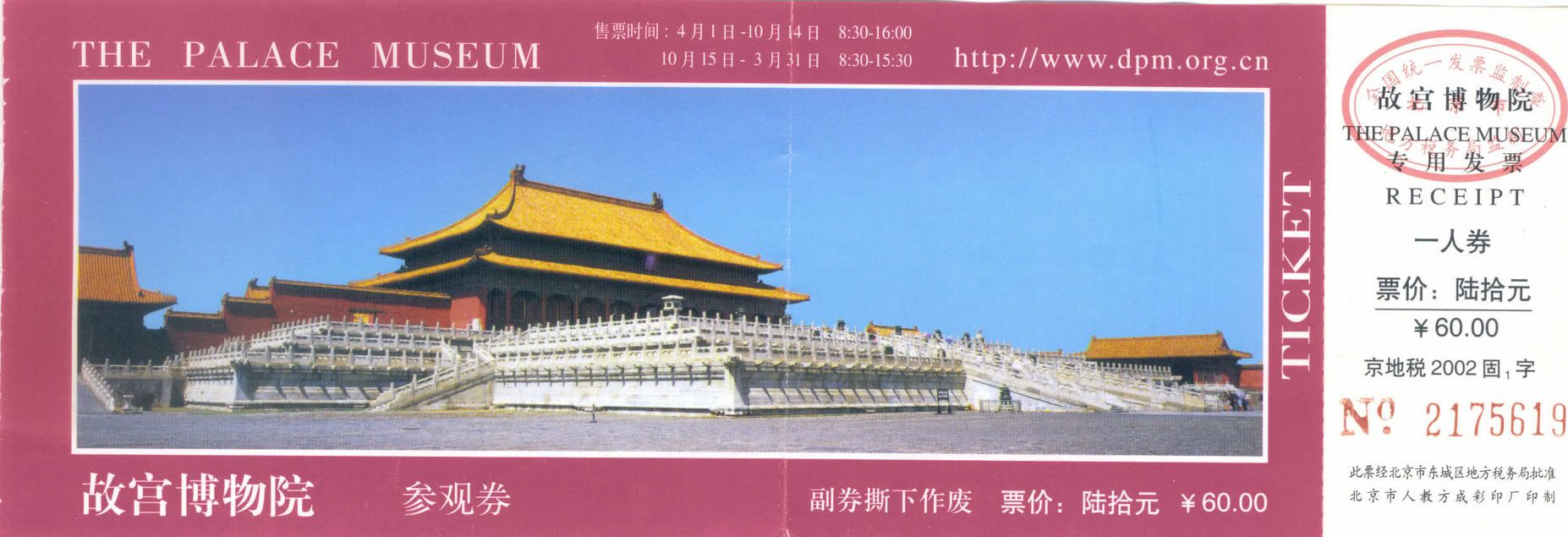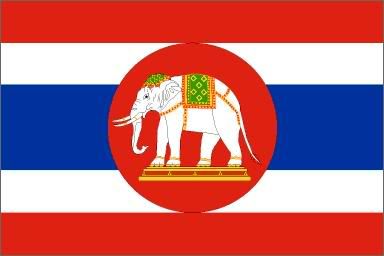TWO YEARS AGO: IMPERIAL PALACE
June 6, 2003, was my second full day in Beijing at the beginning of my "SARS Tour of Asia". I'd spent the previous day discovering my limitations. A hike up the Great Wall at Juyongguan Pass left me breathless in more ways than one — not only was the scenery absolutely spectacular but the combination of flying halfway around the world, lack of sleep, and being somewhat out-of-shape took their toll on me.
I returned to my guest house rather early in the afternoon and spent the evening laying on the bed channel surfing Chinese television until I dozed off.
Early the morning of the 6th, I awoke and had my first "real" meal since arriving in China (a hamburger at a McDonald's the previous day doesn't count since all I had to do was point to the picture and I knew what I would be receiving). At the guest house's small dining room, I had two choices: Chinese breakfast or Western breakfast. Being the adventurer I am, I chose the latter. The plate came with several slices of burnt toast covered in butter, some very good bacon, a few slices of apple, two hard-boiled eggs, a cup with a large ball of cheese, and the best cup of coffee I've ever had.
Fortified, I set out on foot for my goal of the day: The Forbidden City, AKA Imperial Palace, AKA Palace Museum. Although it was still very early in the morning — just after 8:30 — the city was already pulsating with activity. My guest house was located in the center of a hutong (ancient alley) and I was always surprised at the amount of traffic (autos, bicycles, pedestrians) whenever I emerged onto Dongdan Beidajie. The sounds are really what I remember the most — particularly the screeching of bad breaks and the constant ringing of hundreds of bicycle bells. Luckily, I preserved a number of those sounds through my camcorders microphone. Too bad I couldn't record the smells as they were numerous and varied (not always pleasant).
It took me about 40 minutes to walk down to the main thoroughfare (Jianguomennai Dajie) where I turned right and walked another 20 minutes or so to the famous Gate Of Heavenly Peace. This national symbol was built in the 15th century; it was from here that Chairman Mao declared the People's Republic of China on October 1, 1949. To the left of his massive portrait is the slogan, "Long Live the People's Republic of China," and to the right, "Long Live the Unity of the Peoples of the World." In front of the gate are seven bridges spanning a stream — each was restricted in use and only the emperor could use the central bridge and doorway into the gate.
Entering the gate, I then began walking up the long corridor towards the Meridian Gate and the actual entrance to the Forbidden City. As I had been at the Great Wall the day before, I was the only tourist and I walked past the numerous empty ticket booths. About halfway through this corridor, I came across a squadron of People's Liberation Army soldiers doing their morning drills — directly opposite a very ancient cannon.
Just outside of the main ticket booth, I came across my first touts of the trip. One persistent young man managed to sell me several packets of postcards but I later regretted I hadn't also purchased his proferred "Little Red Book" (it wasn't until after I returned to the States that I finally found another suitably authentic copy). And after much encouragement, I finally handed over my camera to this person so he could take a couple of photographs of me standing in front of Wumen (Meridian Gate) — he took these while crouching on the ground and the result was the two single worst photos I believe I've ever been in, this coming from a person who notoriously hates having his photo taken in the first place!
I paid my 60 yuan entrance fee (which was double what the guidebook said it would be but still a bargain at just over $7 U.S.) and for this I received another gigantic ticket stub, plus a large laminated pass I had to wear around my neck during the visit. I declined to take the audio tour — narrated by actor Roger Moore — because doing so would have entailed leaving either my passport or a 300 yuan deposit (considering how large the palace complex truly is, I never would have been able to backtrack all that way anyway).


Meridian Gate was built in 1420 and was the location where emperors reviewed their armies. The left entrance was for court officials and the right for the Imperial family. Just inside the gate is a wide courtyard with five marble bridges spanning the Golden River.
The next gate is Tai He Dian, or the Gate of Great Harmony, which leads to the first large ceremonial hall — the Hall of the Imperial Throne. This is where the emperor marked the new year, important birthdays, and other grand occasions.
To be perfectly honest, most of my wanderings through the vastness of the Forbidden City — gate after courtyard after hall — all began to take on a surrealness at this point.
The day was heating up, already the humidity was causing me to sweat between my shirt and my green daypack. I was virtually alone — I did see a few Chinese, Japanese, and Korean tourists and the occasional pair of PLA soldiers marching through the empty courtyards. At any rate, the entire place was extremely empty — I was used to seeing photos with vast crowds.
I was indeed thankful for the solitude most of the time. It would have been nice, however, to share the experience with someone. But I insisted on not letting the SARS pandemic change my plans for this trip. My friends certainly weren't that adventurous!
At any rate, my trek through the Imperial Palace felt like I was in a daze much of the time — the various halls, etc. all began to look exactly the same and I often wondered how much farther to the northern gates.
Somewhere in the center of the palace, a woman approached me and asked if I was Canadian. She was very impressed when I told her I was from America — she hadn't seen any American visitors in many months. She was an art teacher and soon invited me to view an exhibition in one of the halls. I ended up purchasing several nice paintings.
By this time, I began seeing glimpses of Meishan (Coal Hill), a tall promontory in Jingshan Park just to the north of Forbidden City created from the excavations of the Imperial moat in 1420. I knew that the exit from the Palace was getting closer.
But distances in China are often deceiving and it turned out I had a great ways to go still. It's interesting watching the digital film footage I shot — I filmed each new hall that had a descriptive sign on the outside, horribly mispronoucing the Pinyin characters.
Finally, I emerged from the Palace of Earthly Tranquility into the Imperial Gardens, the northernmost section of the Forbidden City. In contrast with the rest of the day, there were all sorts of trees and plants and shady places to rest. I even found a kiosk where I bought a bottle of soda. It would have been quite peaceful were it not for an overhead loudspeaker blaring Communist propaganda.
As I walked out Shenwu Gate, I immediately heard the symphony of screeching brakes from the busses travelling along Jingshangian Jie. It had literally been hours since I'd heard such city sounds.
My original plan had been to walk across the street and explore Jingshan Park. But upon emerging from the Forbidden City I was accosted by several touts as I identified myself as a tourist by having my camcorder out trying to film the moat. One man repeatedly tried to sell me several soapstone carvings of the Buddha while another walked in front of us painting my portrait on a small bowl.
It's very amusing to listen watch my video shots of the northern gate of the Palace with the tout in the background trying to bargain with me as I repeatedly tell him — in Chinese as well as English — "no thanks". In the end, I did buy six tiny Buddhas, two Imperial lions, and one really cool looking dragon from this man but at a greatly reduced price. I also bought the portrait the man painted of me while walking ahead of my "entourage" (it's one of my favorite souvenirs, he even signed and dated it). The third person gathered around me at this time was a pedicab driver who ended up "rescuing" me as I alighted into his cab and he drove me through a maze of hutongs back to the Wangfujing shopping street. (Another highlight of my videography is one moment you hear me saying "no" to the touts and the next moment the camera is filming the alleyways of old Beijing from the pedicab. Footage worthy of some kind of non-National Geographic documentary!)
It was still fairly early in the day at this point so I spent some time wandering around the pedestrian mall of Wangfujing, filming some of the street scenes such as the model race cars being driven around a courtyard in front of a statue of Mao. I browsed among the stalls of DVD's and decided to enter the Foreign Language Bookstore. At the entrance, I had to go through a large machine that took my temperature — the first evidence of SARS prevention I'd seen since arriving in Beijing. The guard (I'm not certain if he was PLA or local police) examined my passport and I had to fill out a form saying which cities I'd visited in the previous seven days and where I had been that day. At the time, I was a bit taken aback but filling out such forms would soon become routine — particularly during my overnight train and subsequent stay in Shanghai.
In the Foreign Language Bookstore, I purchased two CD's of traditional Chinese folk music — for the equivalent of around $1.50 U.S. each. They turned out to be good buys since I still listen to both of them from time to time when I just want to relax.
I again had a hamburger at the McDonald's on my walk back to Haoyuan; when I finally arrived in the hutong where the guesthouse was located, I walked a bit further along and bought some soda and snacks at a mom & pop stand. This was to be my backpack "nourishment" for much of the following day. My evening was again spent watching Chinese television, as well as transferring photos from my digital camera into my laptop and charging batteries of all of my electronics. This would be the beginning of the end to my nightly computer ritual as I managed to "zap" my laptop battery by plugging in the wrong power adapter. It was just as well as it was taking up too much of my time in the evenings when I could have been out enjoying the twilight.
My evening was again spent watching Chinese television, as well as transferring photos from my digital camera into my laptop and charging batteries of all of my electronics. This would be the beginning of the end to my nightly computer ritual as I managed to "zap" my laptop battery by plugging in the wrong power adapter. It was just as well as it was taking up too much of my time in the evenings when I could have been out enjoying the twilight.












ไม่มีความคิดเห็น:
แสดงความคิดเห็น